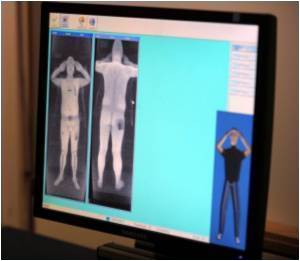The efficacy of a wearable, portable PET scanner developed for rats has been demonstrated by scientists from the U.S. Department of Energy's (DOE) Brookhaven National Laboratory

"Positron emission tomography (PET) is a powerful tool for studying the molecular processes that occur in the brain," said Paul Vaska, head of PET physics at Brookhaven with a joint appointment at Stony Brook, who led the development of the portable scanner together with Brookhaven colleagues David Schlyer and Craig Woody. PET studies in animals at Brookhaven and elsewhere have helped to uncover the molecular underpinnings of conditions such as drug addiction.
But studying animals with PET has required general anesthesia or other methods to immobilize the animals. "Immobilization and anesthesia make it impossible to simultaneously study neurochemistry and the animals' behavior - the actions resulting from what goes on in the brain," Schlyer said. "Our approach was to eliminate the need for restraint by developing a PET scanner that would move with the animal, thus opening up the possibility of directly correlating the imaging data with behavioral data acquired at the same time."
After several years of development, the scientists have arrived at a design for a miniature, portable, donut-shaped PET scanner that can be "worn" like a collar on a rat's head for simultaneous studies of brain function and behavior. Weighing only 250 grams, the device - dubbed RatCAP, for Rat Conscious Animal PET - is counterbalanced by a system of springs and motion stabilizers to allow the animal significant freedom of movement. Measurements of the rats' stress hormones indicated only moderate and temporary increases.
"Rats wearing the device appear to adapt well and move freely about their environment," Woody said.
To validate the use of the wearable scanner for simultaneous studies of brain function and behavior, the scientists conducted tests with 11C-raclopride, a commonly used PET radiotracer, which incorporates a radioactive, positron-emitting isotope of the element carbon. When the positrons interact with electrons in ordinary matter, they immediately annihilate one another, emitting back-to-back gamma rays. Detectors in the circular PET scanner pick up the signals from these back-to-back gamma rays to identify the location and concentration of the tracer in the body.
Advertisement
The main test was to see if the wearable scanner could be used to correlate dopamine levels with behavior - in this case, the rats' activity (i.e., movement) within their chambers. Surprisingly the level of activity was inversely related to dopamine levels - that is, the more active the animals were, the lower the level of dopamine (as indicated by a stronger tracer signal).
Advertisement
"But regardless of the direction, the results clearly demonstrate that RatCAP can correlate brain function measurements with behavioral measures in a useful way," she said.
The scientists also present results comparing RatCAP-wearing rats moving freely about their cages with animals that had been anesthetized, as well as comparisons of two methods of administering the tracer - injecting it all at once and in a steady infusion to maintain a constant concentration in the blood.
"These measurements will help us further refine the technique and aid in our assessment of results obtained with RatCAP in comparison with other study techniques," Schulz said.
The researchers' next step will be to use RatCAP to explore distinct behavioral expressions that can be correlated with simultaneously acquired PET data.
The research was funded by the DOE Office of Science. Development of RatCAP was a joint effort between Brookhaven's Medical, Chemistry and Physics Departments, Instrumentation Division and the Biomedical Engineering Department at Stony Brook University. Co-authors on the paper include: Daniela Schulz (Brookhaven), Sudeepti Southekal (Brigham & Women's Hospital, Boston),Sachin S. Junnarkar (Brookhaven), Jean-François Pratte (Université de Sherbrooke, Sherbrooke, Canada), Martin L. Purschke (Brookhaven), Paul O'Connor (Brookhaven), Sean P. Stoll (Brookhaven), Bosky Ravindranath (Stony Brook), Sri Harsha Maramraju (Stony Brook), Srilalan Krishnamoorthy (Stony Brook), Fritz A. Henn (Brookhaven and Cold Spring Harbor Laboratory), Craig L. Woody (Brookhaven), and David J. Schlyer and Paul Vaska (Brookhaven and Stony Brook).
All research involving laboratory animals at Brookhaven National Laboratory is conducted under the jurisdiction of the Lab's Institutional Animal Care and Use Committee (IACUC, http:www.bnl.gov/ora/IACUC.asp) in compliance with the Public Heath Service (PHS) Policy on Humane Care and Use of Laboratory Animals (http://grants.nih.gov/grants/olaw/references/phspol.htm), the U.S. Department of Agriculture's Animal Welfare Act (http://www.nal.usda.gov/awic/legislat/usdaleg1.htm), and the National Academy of Sciences' Guide for the Care and Use of Laboratory Animals (http://www.nap.edu/readingroom/books/labrats/). This research has enhanced understanding of a wide array of human medical conditions including cancer, drug addiction, Alzheimer's and Parkinson's diseases, and normal aging and has led to the development of several promising treatment strategies.
One of ten national laboratories overseen and primarily funded by the Office of Science of the U.S. Department of Energy (DOE), Brookhaven National Laboratory conducts research in the physical, biomedical, and environmental sciences, as well as in energy technologies and national security. Brookhaven Lab also builds and operates major scientific facilities available to university, industry and government researchers. Brookhaven is operated and managed for DOE's Office of Science by Brookhaven Science Associates, a limited-liability company founded by the Research Foundation of State University of New York on behalf of Stony Brook University, the largest academic user of Laboratory facilities, and Battelle, a nonprofit, applied science and technology organization.
Visit Brookhaven Lab's electronic newsroom for links, news archives, graphics, and more at http://www.bnl.gov/newsroom , or follow Brookhaven Lab on Twitter, http://twitter.com/BrookhavenLab .
Source-Eurekalert








